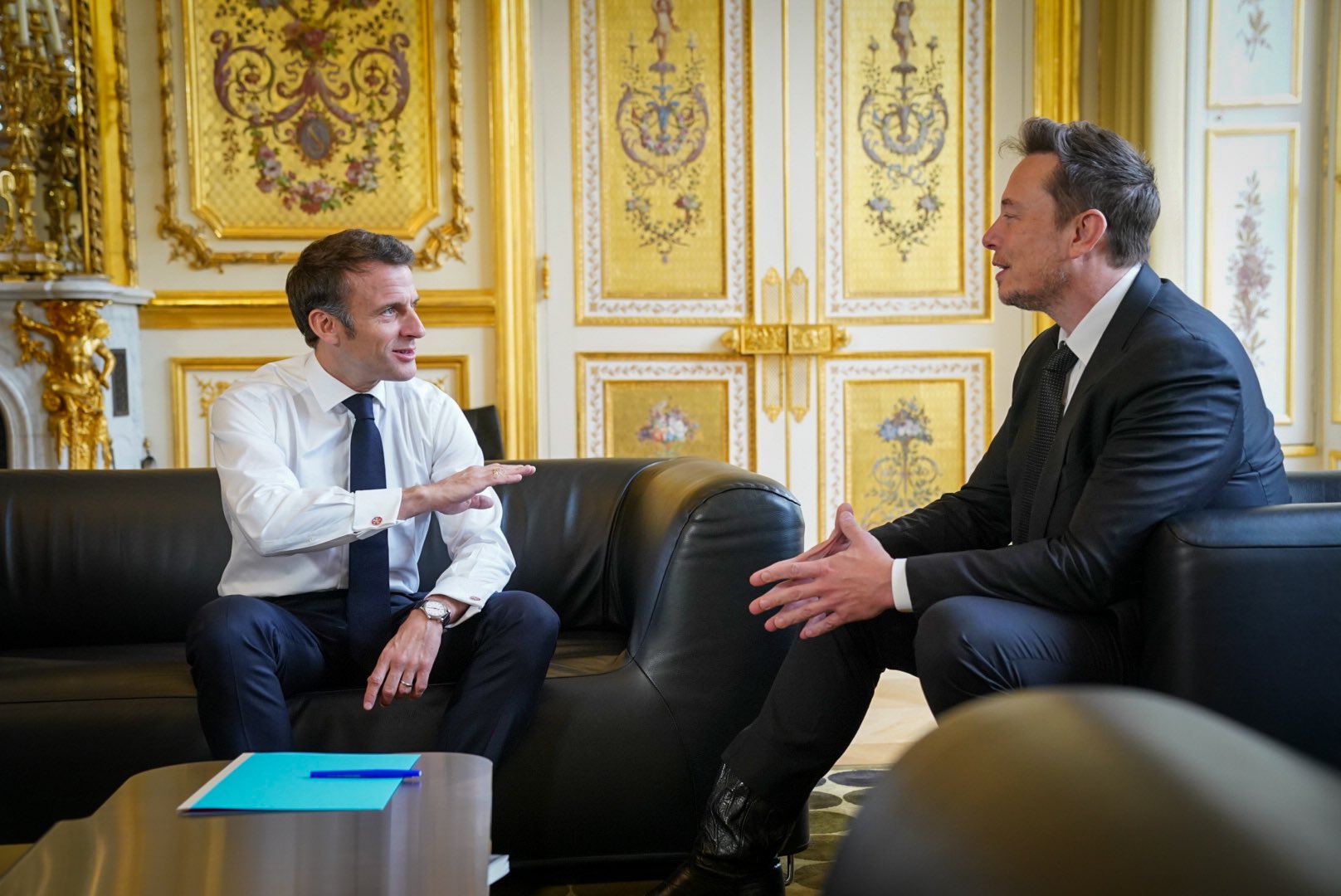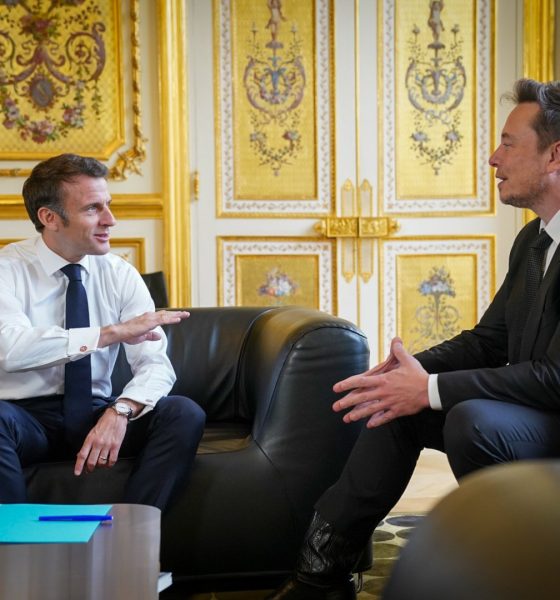

News
Elon Musk courted by French President as Tesla eyes global expansion
Tesla CEO Elon Musk has met with the President of France, Emmanuel Macron, as the automaker considers furthering its global expansion.
Alongside its dramatic production ramp, Tesla has been growing its global market presence in parallel. This has included founding new facilities outside its home market of the United States and entering countless new markets with its popular Model 3 and Model Y vehicles. As Tesla hopes to maintain this production ramp, its CEO, Elon Musk, has been courted by French President Emmanual Macron ahead of a business summit in Versailles.
Elon Musk has been on a world tour in recent months, heading to South Korea, Indonesia, and Mexico, and has now made his way to France. The French President announced the meeting with Elon Musk on Twitter earlier today. He explained that the two leaders had met regarding EV technology, the future of energy, and “the attractiveness of France,” among other topics.
With @ElonMusk, we talked about the attractiveness of France and the significant progress in the electric vehicle and energy sectors. We also talked about digital regulation. We have so much to do together. See you this afternoon at the #ChooseFrance Summit! pic.twitter.com/wkdwjv45OG
— Emmanuel Macron (@EmmanuelMacron) May 15, 2023
The meeting between Macron and Musk comes at a critical time for both leaders. In the case of Elon Musk, Tesla is facing increasing competition in each of its global markets, not the least of which being Europe, on top of mounting pressure to maintain an incredible production ramp, which has made Tesla the guiding EV business globally. As for President Macron, the French leader faces increasing political pressure, including a slim majority in both houses of the French Government and a creeping level of unpopularity in the country.
Tesla is taking its time choosing its next production location, which could easily come to any of the countries the fast-paced CEO has met with in recent months. Tesla is already in the process of establishing its first facility in Mexico, yet many analysts believe that a need for more production in Europe and Asia could drive the automaker to establish new footholds in those key markets.
Looking to Europe, Tesla maintains a substantial market share in many key countries, including France, the U.K., Germany, and the EV leader, Norway. To maintain this lead and help reduce general production reliance on China, France could be a key contributor if Tesla were to establish a new facility in the country.
Following the meeting, Musk elaborated that Tesla will be investing in France at some point, but specifics regarding what that investment could look like remain unknown.
ELON MUSK IN FRANCE: TESLA WILL MAKE SIGNIFICANT INVESTMENTS IN FRANCE AT SOME POINT
— First Squawk (@FirstSquawk) May 15, 2023
While this statement may sound like France’s admission into Tesla’s fleet of production centers is secured, that is likely not the case. If Tesla were to establish a new facility in Europe, it would likely be a highly competitive choice. While France may be working to develop a more business-friendly environment, Germany has long been the automotive center of Europe. At the same time, countries like Spain, Poland, and Turkey have all been common production choices for the world’s top automakers.
Further courting the CEO, as noted in the tweet from the French President, both Macron and Musk will be attending the “Choose France” Summit, which is set to not only unveil roughly 13 billion euros of new business investments into the country but also tout France as the market of choice for expanding businesses in Europe.
What do you think of the article? Do you have any comments, questions, or concerns? Shoot me an email at william@teslarati.com. You can also reach me on Twitter @WilliamWritin. If you have news tips, email us at tips@teslarati.com!

Elon Musk
Elon Musk and Tesla AI Director share insights after empty driver seat Robotaxi rides
The executives’ unoccupied tests hint at the rapid progress of Tesla’s unsupervised Robotaxi efforts.

Tesla CEO Elon Musk and AI Director Ashok Elluswamy celebrated Christmas Eve by sharing personal experiences with Robotaxi vehicles that had no safety monitor or occupant in the driver’s seat. Musk described the system’s “perfect driving” around Austin, while Elluswamy posted video from the back seat, calling it “an amazing experience.”
The executives’ unoccupied tests hint at the rapid progress of Tesla’s unsupervised Robotaxi efforts.
Elon and Ashok’s firsthand Robotaxi insights
Prior to Musk and the Tesla AI Director’s posts, sightings of unmanned Teslas navigating public roads were widely shared on social media. One such vehicle was spotted in Austin, Texas, which Elon Musk acknowleged by stating that “Testing is underway with no occupants in the car.”
Based on his Christmas Eve post, Musk seemed to have tested an unmanned Tesla himself. “A Tesla with no safety monitor in the car and me sitting in the passenger seat took me all around Austin on Sunday with perfect driving,” Musk wrote in his post.
Elluswamy responded with a 2-minute video showing himself in the rear of an unmanned Tesla. The video featured the vehicle’s empty front seats, as well as its smooth handling through real-world traffic. He captioned his video with the words, “It’s an amazing experience!”
Towards Unsupervised operations
During an xAI Hackathon earlier this month, Elon Musk mentioned that Tesla owed be removing Safety Monitors from its Robotaxis in Austin in just three weeks. “Unsupervised is pretty much solved at this point. So there will be Tesla Robotaxis operating in Austin with no one in them. Not even anyone in the passenger seat in about three weeks,” he said. Musk echoed similar estimates at the 2025 Annual Shareholder Meeting and the Q3 2025 earnings call.
Considering the insights that were posted Musk and Elluswamy, it does appear that Tesla is working hard towards operating its Robotaxis with no safety monitors. This is quite impressive considering that the service was launched just earlier this year.
Elon Musk
Starlink passes 9 million active customers just weeks after hitting 8 million
The milestone highlights the accelerating growth of Starlink, which has now been adding over 20,000 new users per day.

SpaceX’s Starlink satellite internet service has continued its rapid global expansion, surpassing 9 million active customers just weeks after crossing the 8 million mark.
The milestone highlights the accelerating growth of Starlink, which has now been adding over 20,000 new users per day.
9 million customers
In a post on X, SpaceX stated that Starlink now serves over 9 million active users across 155 countries, territories, and markets. The company reached 8 million customers in early November, meaning it added roughly 1 million subscribers in under seven weeks, or about 21,275 new users on average per day.
“Starlink is connecting more than 9M active customers with high-speed internet across 155 countries, territories, and many other markets,” Starlink wrote in a post on its official X account. SpaceX President Gwynne Shotwell also celebrated the milestone on X. “A huge thank you to all of our customers and congrats to the Starlink team for such an incredible product,” she wrote.
That growth rate reflects both rising demand for broadband in underserved regions and Starlink’s expanding satellite constellation, which now includes more than 9,000 low-Earth-orbit satellites designed to deliver high-speed, low-latency internet worldwide.
Starlink’s momentum
Starlink’s momentum has been building up. SpaceX reported 4.6 million Starlink customers in December 2024, followed by 7 million by August 2025, and 8 million customers in November. Independent data also suggests Starlink usage is rising sharply, with Cloudflare reporting that global web traffic from Starlink users more than doubled in 2025, as noted in an Insider report.
Starlink’s momentum is increasingly tied to SpaceX’s broader financial outlook. Elon Musk has said the satellite network is “by far” the company’s largest revenue driver, and reports suggest SpaceX may be positioning itself for an initial public offering as soon as next year, with valuations estimated as high as $1.5 trillion. Musk has also suggested in the past that Starlink could have its own IPO in the future.
News
NVIDIA Director of Robotics: Tesla FSD v14 is the first AI to pass the “Physical Turing Test”
After testing FSD v14, Fan stated that his experience with FSD felt magical at first, but it soon started to feel like a routine.

NVIDIA Director of Robotics Jim Fan has praised Tesla’s Full Self-Driving (Supervised) v14 as the first AI to pass what he described as a “Physical Turing Test.”
After testing FSD v14, Fan stated that his experience with FSD felt magical at first, but it soon started to feel like a routine. And just like smartphones today, removing it now would “actively hurt.”
Jim Fan’s hands-on FSD v14 impressions
Fan, a leading researcher in embodied AI who is currently solving Physical AI at NVIDIA and spearheading the company’s Project GR00T initiative, noted that he actually was late to the Tesla game. He was, however, one of the first to try out FSD v14.
“I was very late to own a Tesla but among the earliest to try out FSD v14. It’s perhaps the first time I experience an AI that passes the Physical Turing Test: after a long day at work, you press a button, lay back, and couldn’t tell if a neural net or a human drove you home,” Fan wrote in a post on X.
Fan added: “Despite knowing exactly how robot learning works, I still find it magical watching the steering wheel turn by itself. First it feels surreal, next it becomes routine. Then, like the smartphone, taking it away actively hurts. This is how humanity gets rewired and glued to god-like technologies.”
The Physical Turing Test
The original Turing Test was conceived by Alan Turing in 1950, and it was aimed at determining if a machine could exhibit behavior that is equivalent to or indistinguishable from a human. By focusing on text-based conversations, the original Turing Test set a high bar for natural language processing and machine learning.
This test has been passed by today’s large language models. However, the capability to converse in a humanlike manner is a completely different challenge from performing real-world problem-solving or physical interactions. Thus, Fan introduced the Physical Turing Test, which challenges AI systems to demonstrate intelligence through physical actions.
Based on Fan’s comments, Tesla has demonstrated these intelligent physical actions with FSD v14. Elon Musk agreed with the NVIDIA executive, stating in a post on X that with FSD v14, “you can sense the sentience maturing.” Musk also praised Tesla AI, calling it the best “real-world AI” today.








